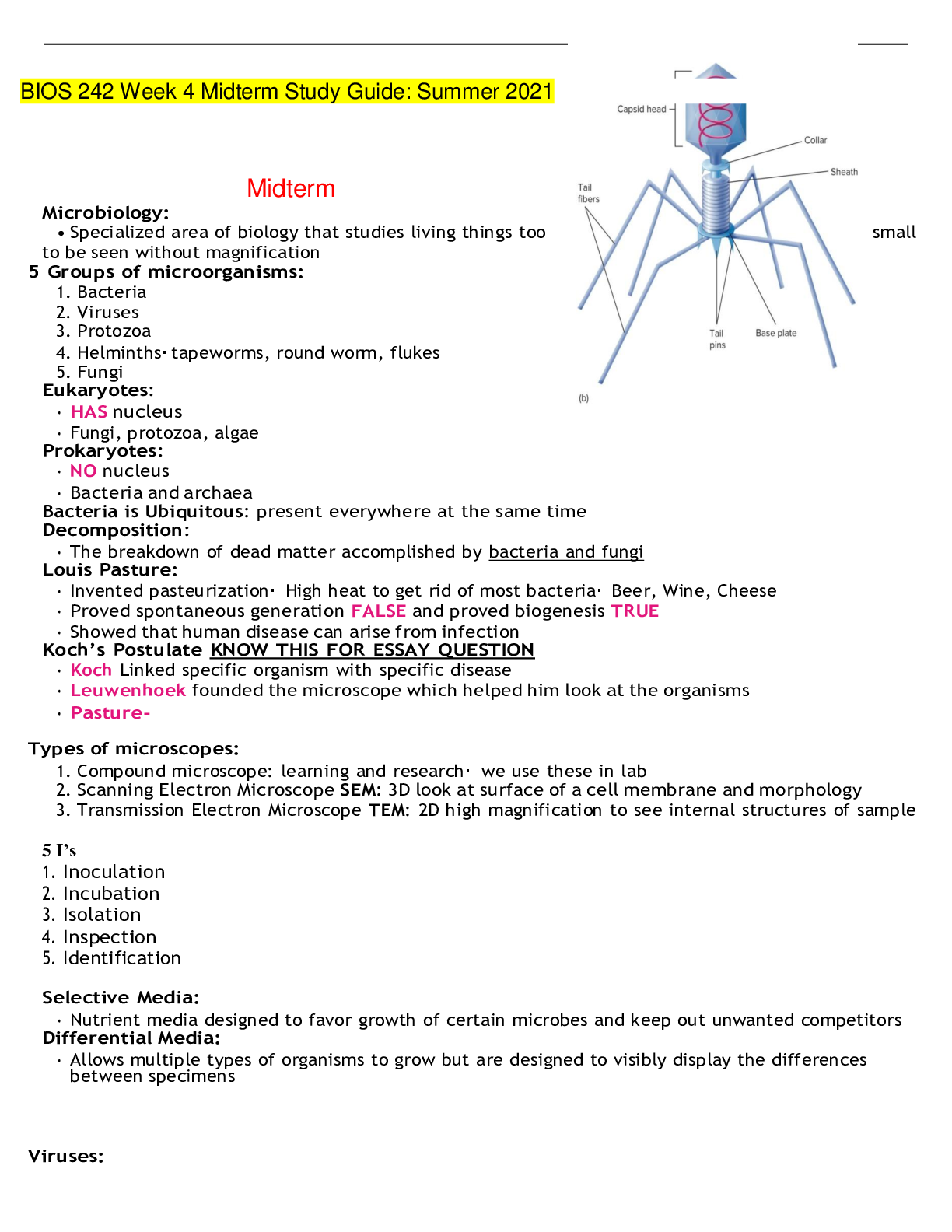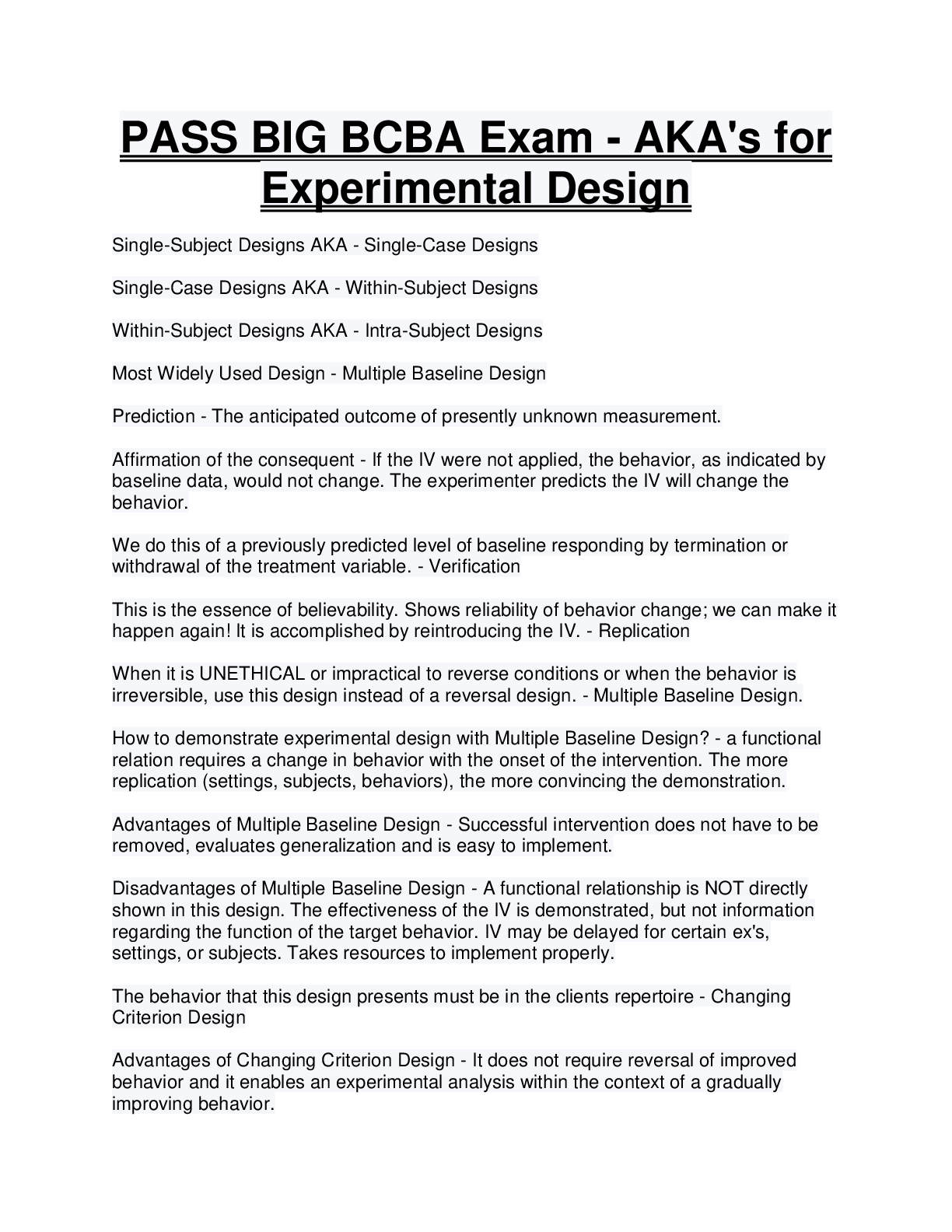Micro Biology > Solutions Guide > BIOS 242 Week 4 Midterm StudyGuide: Summer . (All)
BIOS 242 Week 4 Midterm StudyGuide: Summer .
Document Content and Description Below
• Required Resources Read/review the following resources for this activity: • Chapter 1-13 • Lesson 1-4 • Instructions: The maximum time you can spend in the exam is 90 minu... tes. If you have not clicked the "Submit quiz" button by then, you will be exited from the exam automatically. • Your answers will be auto-saved as you complete each question. This helps prevent connection timeouts that might occur with certain Internet service providers, and it also minimizes lost answers in the event of connection problems. If your Internet connection does break, when you reconnect you will normally be able to get back into your exam without any trouble. Just click on the "Resume quiz" button to continue. Remember, though, that the exam timer continues to run while you are disconnected, so you should try to log in again as quickly as possible. The Help Desk cannot grant any student additional time on the exam—students must contact the instructor. • After the exam is graded and returned to you, the exam score and the instructor's feedback will be available; please contact your instructor if you would like to discuss your results. Please be aware that the exam questions, responses, and solutions will not be available once the exam is submitted. • Take the quiz for this week. • Question Type(s): Multiple Choice, All That Apply, Matching & Essay • Time Limit: 90 minutes • Attempts: 1 • Prokaryotes - bacteria and archaea • Eukaryotes - animals, plants, protists, fungi • virus, viroids, Prions - are acellular and are not considered living organisms • Bacteria are single-celled prokaryotes whose cell walls are composed of peptidoglycan (though some bacteria lack cell walls). They reproduce asexually. Most are beneficial, but some cause disease. • Archaea are prokaryotes whose cell walls lack peptidoglycan and instead are composed of other polymers. They reproduce asexually. None are known to cause disease. PROKARYOTES – Bacteria are single-celled • whose cell walls are composed of peptidoglycan (though some bacteria lack cell walls). They reproduce asexually. Most are beneficial, but some cause disease. Archaea are prokaryotes • whose cell walls lack peptidoglycan and instead are composed of other polymers. They reproduce asexually. None are known to cause disease. • Eukaryotes are organisms whose cells contain a nucleus composed of genetic material surrounded by a distinct membrane. EXAMPLES OF EUKARYOTES • Fungi are relatively large microscopic eukaryotes and include multicellular molds and single-celled yeasts. These organisms obtain their food from other organisms and have cell walls made of a polymer called chitin. • Protozoa are single-celled eukaryotes that are similar to animals in their nutritional needs and cellular structure. Most are capable of locomotion, and some cause disease. • Algae are plantlike eukaryotes that are photosynthetic; that is, they make their own food from carbon dioxide and water, using energy from sunlight. The algae include multicellular and unicellular organisms. • Parasitic worms are invertebrate worm like animals that cause several infectious diseases. They range in size from microscopic forms to adult tapeworms several meters in length. • Viruses are acellular obligatory parasites and are not considered eukaryotes or prokaryotes. Microscopes are important diagnostic tools for observing microbes and acellular structures. • Viruses- Acellular infectious agents, can infect bacteria or any other eukaryotic cells. Made up of nucleic acid (DNA or RNA) and protein coat only. • Viruses - cause a variety of human diseases ranging from the common cold to AIDS • Viruses - are miniscule, acellular, infectious agents that use the host's machinery for replication. • Viruses – Can not grow nor respond to the environment, and consist of genetic material, either DNA or RNA, packaged in a protein coat called a capsid. • They do not have any cytoplasmic membrane, cytosol, or organelles. • Some viruses are enclosed within an envelope membrane. Because they are incapable of replicating outside a host cell, some would argue that these pathogens are not actually alive......... Document continue [Show More]
Last updated: 2 years ago
Preview 1 out of 4 pages

Buy this document to get the full access instantly
Instant Download Access after purchase
Buy NowInstant download
We Accept:

Reviews( 0 )
$8.00
Can't find what you want? Try our AI powered Search
Document information
Connected school, study & course
About the document
Uploaded On
Jul 18, 2021
Number of pages
4
Written in
Additional information
This document has been written for:
Uploaded
Jul 18, 2021
Downloads
0
Views
76














